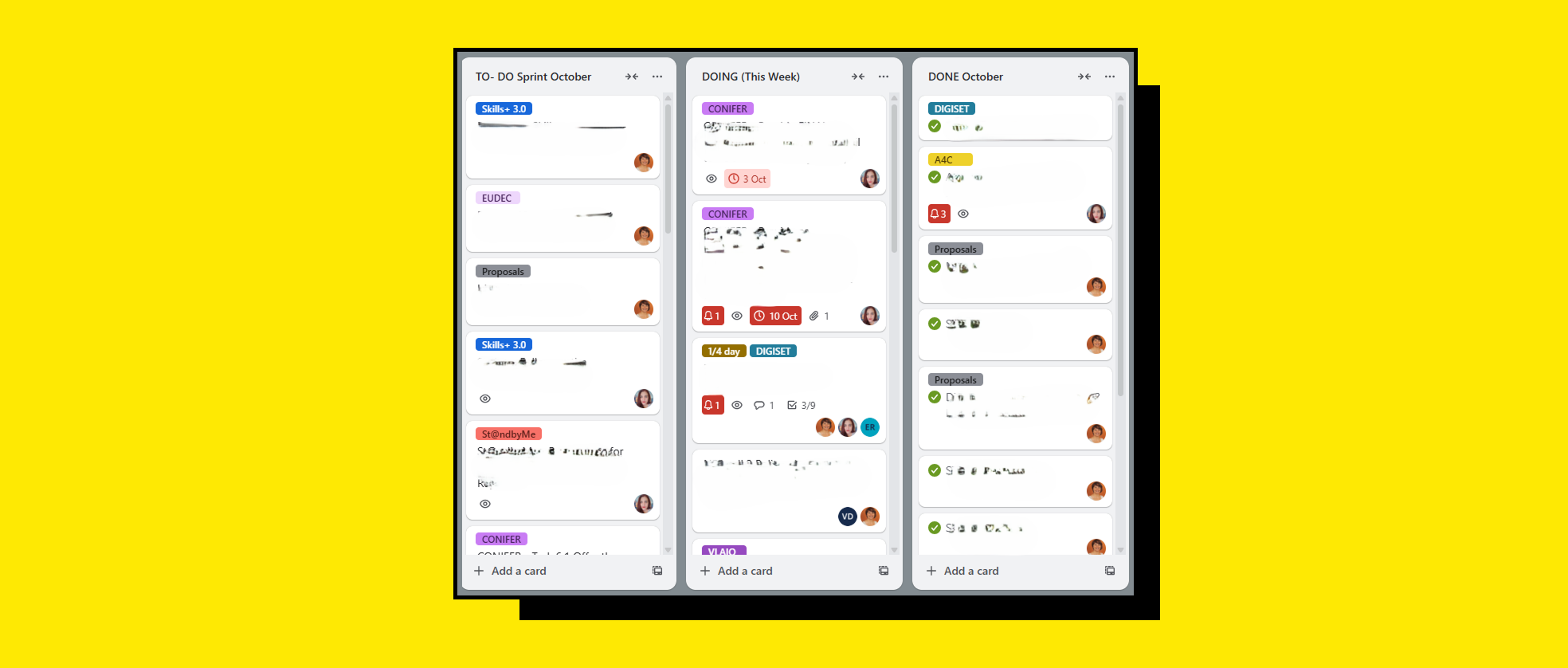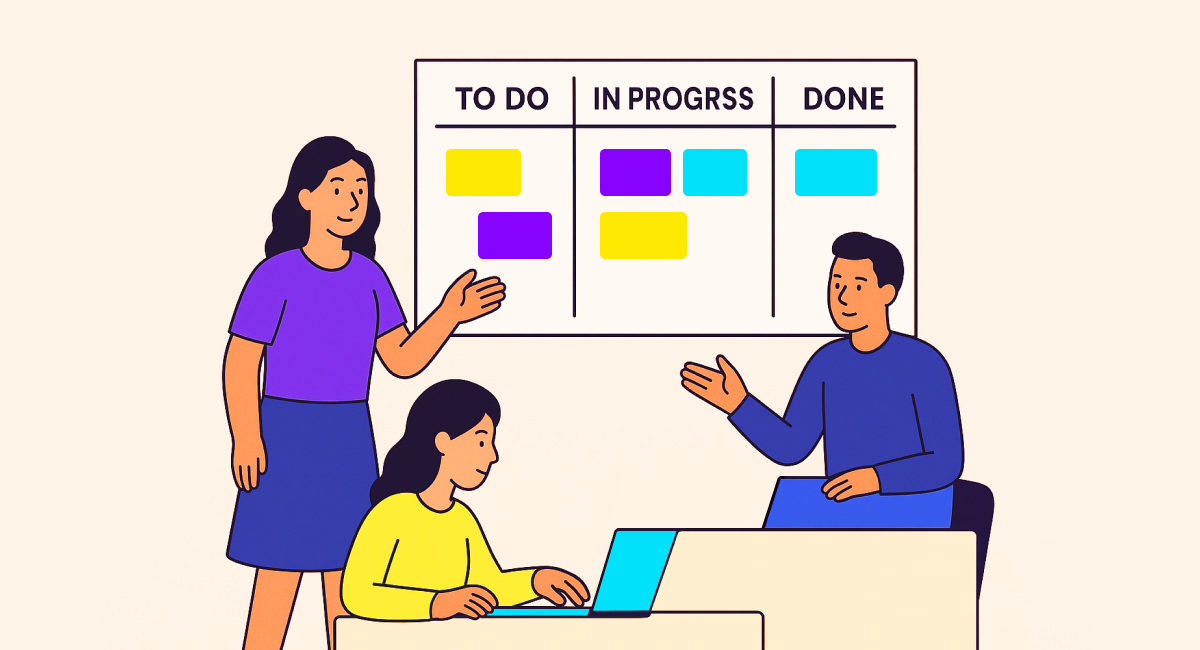Working smarter, not harder: How Agile transforms our teams at CollectiveUP
If you manage projects, you know the feeling. That sinking sensation when a project you’ve been pouring your heart into starts to drift. The goals that once seemed so clear become fuzzy. Team members, once energized, are now buried under a mountain of tasks, unsure of what to tackle next. The communication that flowed so easily at the kick-off meeting has now been replaced by long, confusing email chains and meetings that seem to create more questions than answers.
In our line of work at CollectiveUP, managing a diverse portfolio from EU-funded initiatives to educational resource development, we saw this pattern too often. We realized that projects rarely fail for a lack of vision or passion. They fail because great ideas get lost in translation, somewhere between a daunting to-do list, a shifting deadline, and the simple, human misunderstandings that happen when teams are stretched thin.
For a long time, we operated under the illusion of the "perfect" plan. We would spend weeks, sometimes months, crafting a massive, detailed project plan, believing it would anticipate every possible hurdle. But in the real world of the social economy and education sectors, where stakeholder needs evolve, funding landscapes shift, and community feedback is essential, that "perfect" plan often becomes outdated almost immediately. We were constantly reacting, patching holes, and trying to force our projects back onto a track that no longer served them.
We were working hard, but we weren't always working smart. That’s when we made a conscious decision to embrace Agile project management. And no, this isn't a story about becoming a software company. It's about how we adopted a smarter, more human way of working that has fundamentally transformed our team from simply being busy to being genuinely effective and resilient.
Agile in action: It’s a mindset, not a manual
Many people hear "Agile" and think of complex jargon like "scrum ceremonies" or "velocity tracking." While those have their place, for us, the transition to Agile was first and foremost a cultural one. It meant a fundamental shift in perspective for everyone, from leadership to project coordinators.
We moved from seeing change as a problem to seeing it as an integral part of the process. Instead of building a fortress around a rigid plan, we learned to build a flexible vehicle that could navigate new terrain. This iterative approach, where we test small pieces, learn from the results, and adapt as we go, has been revolutionary.
For instance, when developing a new educational handbook, we no longer spend months writing the entire thing in isolation before seeking feedback. Instead, we outline a core module, develop it, and immediately share it with a small test group. Their feedback directly shapes the next module. This means we catch misalignments early, pivot without massive sunk costs, and ultimately create a final product that is far more relevant and impactful.
This approach means we don’t have to have all the answers on day one. We just have to start, and trust that we’re smart enough to figure it out together along the way. This alone has lifted a huge burden off our teams' shoulders.
Our project game-changer: The simple power of the Kanban Board
If Agile is our new mindset, the Kanban board is the practical tool that made this abstract concept real and accessible for everyone on our team. Imagine a simple visual board with columns: “To Do,” “In Progress,” and “Done.” Its simplicity is its genius.
Before Kanban, work was invisible. It lived in siloed inboxes, private to-do lists, and buried in project management software that no one really checked. The moment we introduced a central, visual Kanban board, first on a physical whiteboard, then digitally for our remote collaborators, everything changed.
Suddenly, the workflow of our entire team became transparent.
- Transparency: Anyone, at a glance, could see the state of a project. No more "where are we with that?" emails.
- Clarity: Bottlenecks became obvious before they became crises. If the "In Progress" column was overflowing, we knew we had a capacity issue and could redistribute tasks before anyone burned out.
- Ownership: Tasks were easier to distribute, and team members naturally took accountability for moving their assigned cards from one column to the next.
"The Kanban board didn't just organize our tasks; it gave us a shared reality. It transformed abstract deadlines into a collective story we were building together, one card at a time." Chrysanthi, our Operations and Project manager says.
At CollectiveUP, our Kanban boards have become our shared language. Whether we’re coordinating a multi-partner event or developing a new training module, it keeps us grounded, aligned, and moving forward together.

Why our teams are thriving with Agile
The most significant change we've witnessed hasn't just been in our workflows or productivity metrics; it's been in our team culture and psychological well-being.
- We collaborate instead of just coordinating. The hierarchy flattens. Teams self-organize around work, fostering a sense of ownership and empowerment that top-down instructions simply cannot match.
- We talk continuously and purposefully. We've replaced long, meandering weekly status meetings with short, focused 15-minute "stand-ups" where everyone answers three questions: What did I accomplish? What am I working on next? Where am I blocked? This ensures everyone is heard, aligned, and obstacles are addressed immediately.
- We see progress faster, which is incredibly motivating. By breaking work into manageable, one- or two-week "sprints," we create a steady rhythm of achievement. Completing a set of tasks feels like a win, and that positive reinforcement keeps energy and morale high.
- We’ve made room for creativity and innovation. Because feedback loops are short and adjustments are expected, experimenting feels safe. A failed experiment is just a learning opportunity, not a project-ending catastrophe.This psychological safety is the fertile ground where true innovation can finally take root and grow.
Building an Agile culture, together
For us at CollectiveUP, adopting Agile isn’t about copying a tech trend or rigidly following a set of rules. It’s about consciously building a culture of adaptability, openness, and collaboration that is perfectly suited for the dynamic world of social innovation.
This cultural shift extends beyond our internal teams. We now bring these principles to our partners and stakeholders. We co-create project roadmaps using Agile frameworks, ensuring that from the very beginning, our collaborations are built on a foundation of flexibility and shared understanding. We're not just delivering reports; we're engaging in a continuous, adaptive process of value creation.
It’s about creating an ecosystem where our team, and our partners, can do their best work, guided by clarity and a shared purpose. We’re moving from reacting to problems to collaboratively designing solutions. And that is what truly changes outcomes and creates lasting impact.
Want to Dive Deeper?
Embarking on an Agile transformation can seem daunting, but you don't have to do it all at once. Start small. Pick one team or one project and introduce a simple Kanban board. Focus on the principles of transparency and continuous improvement before worrying about the more complex practices.
We’ve integrated these hard-won lessons and practical Agile principles into our Open Educational Resources, including our Self-Directed Agile Education for Resilient and Inclusive Collaboration Handbook, which is designed specifically for mission-driven organizations like yours.
👉 Is your organization looking to move from chaotic reactivity to empowered clarity? Do you want to implement Agile methods and Kanban to manage complex projects and foster a more collaborative, resilient team?
→ Contact us at CollectiveUP, and let's co-create the next generation of project management, flexible, inclusive, and built for real, measurable impact








